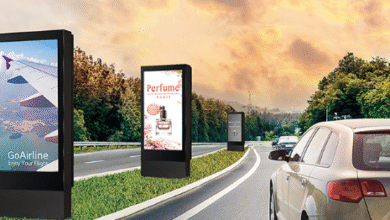Why Flexible Monitors Could Be the Future of Hybrid Workspaces

The last few years have witnessed a dramatic shift in the work culture that we are accustomed to. Hybrid work has given rise to new organizational dynamics which has in turn, caused enterprises to reevaluate their workspace planning and laptop monitor strategies. An increasingly popular, yet often underrated device in recent times is the flexible monitor. With the ability to be easily transported, carried around and enhanced productivity and collaboration, these adjustable and portable monitors are set to become the new standard in hybrid workspaces.
Understanding Hybrid Workspaces
Gone are the days when a conventional 9 to 5 in-office desk job was considered the most prominent workspace arrangement. As people have become more adaptable and prefer a better work-life balance, the paradigm is swiftly changing to accommodate workers who divide their time across a wide variety of locations – home offices, co-working stations, and cafes. At the same time, with employees proving to be just as efficient, if not more, at various workspaces, companies have been keen to review their workstation hardware and software investments in line with these trends.
The need to effectively serve up resources and conduct seamless communication across all these locations has spurred organizations to retool their strategies with technology at the helm. As such, hybrid workspaces don’t merely involve remote access to files or joining virtual meetings, but a concerted effort to make employees productive, irrespective of location. Flexible monitors are quickly becoming the answer to this workspace hardware question.
Flexible monitors 101
A flexible monitor, or simply, a bendable monitor, is a display device that offers its users the ability to curve, fold or otherwise manipulate without sacrificing performance or clarity. Traditional monitors in comparison, although user-friendly and more commonplace, don’t offer much in the way of adjustability, which renders them less than ideal in a hybrid work scenario. Instead, when it comes to flexible monitors, there is a wide array of features that make them well-suited to the current and future needs of the modern professional:
Portability: Ideal for on-the-go work, such bendable and flexible monitors weigh next to nothing and can be easily folded, rolled or put away into a laptop bag. In combination with a laptop, a laptop monitor can instantly increase screen size without adding significant bulk to an existing setup.
Adjustable Orientations: Users can quickly switch between horizontal and vertical views, change tilt angles, or fold/curve the display to better align with activities such as coding, sketching or referencing data.
Enhanced Connectivity: Most flexible monitors come with multiple input options, wireless display features and work well with both desktops and laptops.
Ergonomic Benefits: Adjustable stands, light materials and high-resolution displays make them a healthier choice in the long-term for those who use them.
Why Flexible Monitors Are Essential for Hybrid Workspaces
As established earlier, hybrid work means more than just working from home. People are now expected to be just as active and productive when they travel, are out and about in the field, or even work from a client location for long periods of time. Flexible monitor can help in all of these scenarios.
Productivity
Productivity is the name of the game when it comes to hybrid work. Between juggling multiple tasks like virtual meetings and spreadsheets, communication applications, video calls and creative projects, laptop users are always on the move. Flexible monitors can be deployed in this context for a number of reasons:
Enhanced Screen Size: As the most obvious benefit, additional screens provided by an external portable monitor means professionals can run multiple applications side-by-side instead of jumping from tab to tab.
Minimized Distraction: With a designated display for work and another for reference materials, it is easier to eliminate on-screen clutter that typically comes with smaller laptops. Flexible monitors can be positioned to minimize distractions and glare, allowing for more focus on intensive work tasks.
Multitasking: Working in cross-functional teams often means accessing multiple sources of information at once. Flexible monitors let users do just that and, by extension, improve productivity overall.
Workflow Customization: Flexible monitors can be customized to the individual’s unique needs and workflow. An illustrator can easily roll up or fold a monitor to create an immersive workspace, while a finance professional can use the portrait mode on their laptop monitor to view tall spreadsheets without needing to scroll down.
Collaboration
Collaboration is another key element of hybrid work. It is what makes working from a variety of different locations possible in the first place. Flexible monitors come into play in this sphere in a variety of ways too:
Shared Viewing: During a meeting, flexible monitors can be positioned to ensure everyone has an unobstructed view of whatever shared content is being presented. This is especially useful in office huddles or shared workspaces where everyone may not be able to clearly see a laptop screen.
Presentation Modes: A flexible monitor can be easily adjusted between orientations and even adjusted in size to best present data or creative/financial work to an audience.
Remote Collaboration: Used in conjunction with video conferencing tools, flexible monitors allow for truly effective remote communication by keeping other documents, spreadsheets or a team collaboration platform in view, at all times.
Mobile Collaboration: When it comes to collaboration outside the office, or even with external partners, employees are now able to take their own portable flexible monitor to instantly set up a collaboration workspace, instead of being stuck with just the screen provided on their laptops or desktops.
Ergonomics and well-being
Working a hybrid job can sometimes leave the traditional desk spaces blurred between home and office. In fact, with longer work hours becoming the norm, professionals are susceptible to ergonomic challenges at work such as stiff necks, back pains, eye strain, and repetitive strain injuries. Flexible monitors can easily help resolve many of these issues, including:
Posture: Flexible monitors can be adjusted to the perfect height and angle to make sure that neck and shoulder aches are a thing of the past. This is especially important for workers who frequently switch between desk setups at their home office and the office.
Eye Strain: High-resolution flexible monitors come with customizable brightness and anti-glare features that reduce eye fatigue and allow employees to work for longer periods without strain.
Mental Well-being: Studies have found that clutter-free and adaptable workstations can actually reduce stress and improve cognitive function. As such, the portability and ease-of-use of flexible monitors can contribute to better mental health for employees through a cleaner and more organized workspace.
Sustainability and Space optimization
Flexible monitors also score high on sustainability and space optimization:
Hardware Reduction: One of the largest benefits is simply that one laptop monitor can serve multiple purposes instead of people and companies having to invest in several individual monitors that could potentially go to waste after a certain period of time.
Energy Reduction: As a more modern piece of tech hardware, flexible monitors are energy efficient with their components. This means they consume significantly less power than conventional monitors do.
Compact Storage: Since they are able to be folded up or rolled away, employees and companies alike can save on storage and optimize available desk spaces, which is often at a premium in many urban offices today.
Coupling these functional advantages with a more eco-conscious approach to work makes these bendable monitors an ideal solution for the future.
Industry-Specific Use Cases
Flexible monitors have a wide range of use cases that go beyond a few select industries and use cases:
Creative Industry Professionals: Illustrators, graphic designers, video editors and photographers make use of large bendable displays that allow them to visualize their work and layouts and gain access to flexible workspace layouts.
Finance, Data Analytics: Financial and data professionals who work with spreadsheets are all able to use the portrait mode to view wide documents or use it to multi-task across different applications or data feeds.
Remote Workers, Consultants: Consultants, remote workers and employees who frequently travel with work are the best candidates to take advantage of a portable external monitor so that they can essentially bring their full workstation without the bulk of a conventional display.
Medical and Academic Professionals: Doctors, researchers, academics and anyone who regularly needs to monitor multiple data streams at the same time will find flexible and adjustable monitors an excellent solution for ergonomics and task-specific setups.
The wide applicability of flexible monitors for both everyday work and more specific work needs make them a perfect product for the future.

The Future of Flexible Monitors for Hybrid Work
As flexible monitors are further developed and enhanced, some of their key features will be:
AI-Based Adjustments: Users can expect the monitors of the future to have AI-driven features that can auto adjust brightness, color calibration and even screen orientation according to the tasks and ambient conditions.
AR/VR Enhancements: Flexible monitors can also double up as more immersive AR/VR peripherals as the technology advances, allowing for better training, creative and collaborative work.
Wireless Connectivity: One of the more elusive features of these devices today, wireless options for connecting a flexible monitor with a laptop, desktop or smartphone will become more advanced and reliable.
Durability: Material and design technology will ensure that monitors will become even more bendable and yet sturdier than before.
These developments will only make flexible monitors more central to hybrid work in the future.
Conclusion
Hybrid work has changed how we think about workspaces. Employees expect devices and hardware that is not only compatible with multiple work environments, but is portable, lightweight, and can help them get work done better both alone and in teams. Flexible monitors offer exactly these capabilities with their innovative and versatile displays, ergonomic design and productivity benefits. These laptop monitors are already having a big impact on professional workspaces. With just a laptop monitor, such as a portable monitor for laptop or portable external monitor, professionals can work more effectively from just about anywhere.
Flexible monitors are well-poised to become a central feature of any hybrid workspace going forward. The advantages these bendable monitors offer in terms of function, durability and even space-saving are clear. By integrating these monitors into offices, work-from-home stations and even allowing employees to take their own portable and flexible monitor, enterprises can provide workers with the ideal tools for productivity and well-being. The future is dynamic, it is mobile, and hybrid and flexible monitors are here to stay in every sense of the word.





